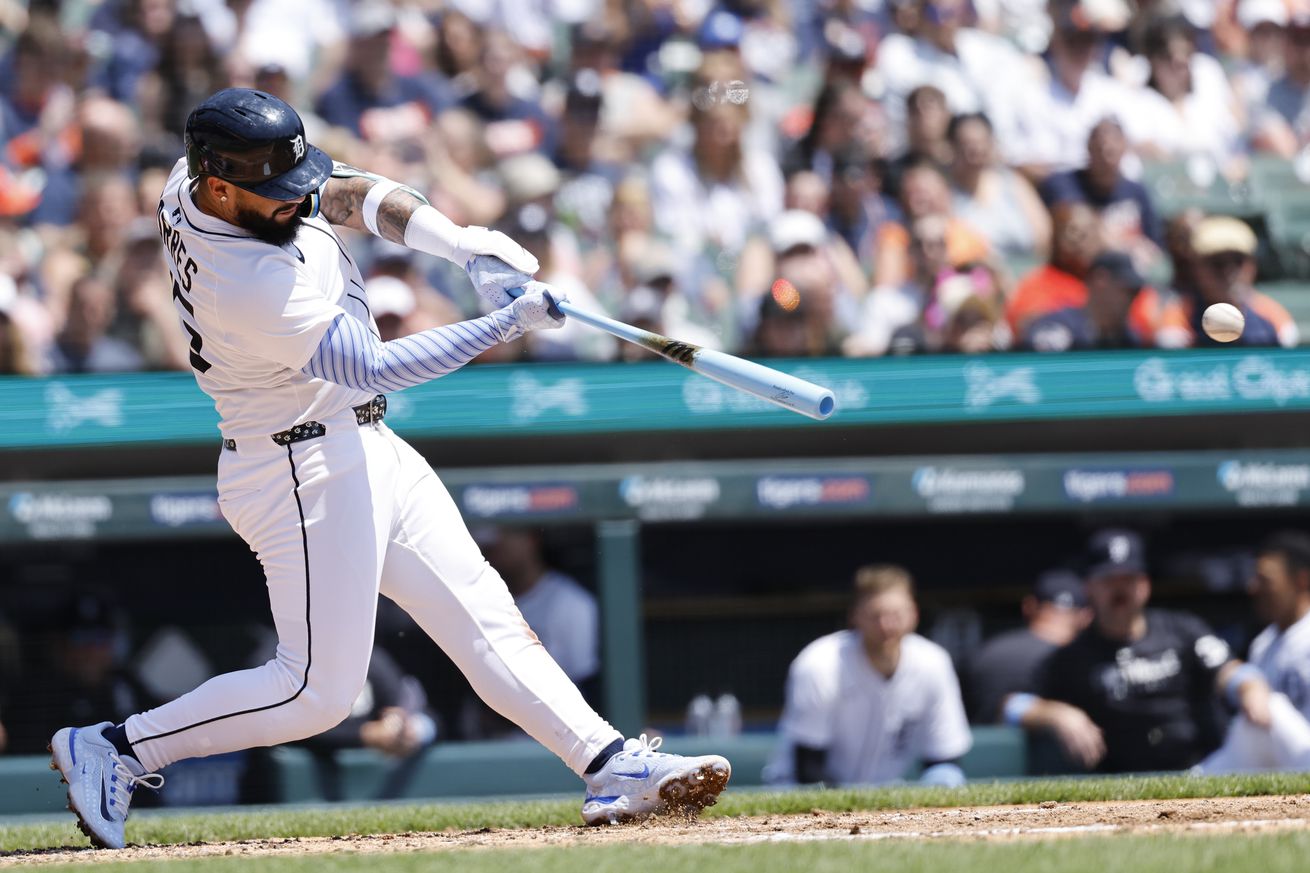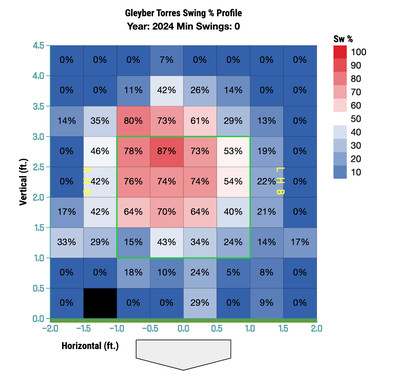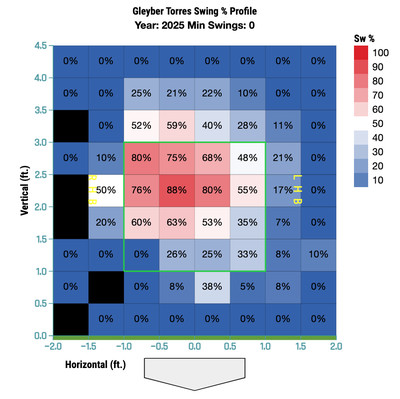
The much-maligned Yankees second baseman has been the offensive presence the Tigers needed.
When Scott Harris launched his Detroit Tigers tenure with “control the zone”, fans immediately jumped to walks and OBP. That’s a great start, but there’s more to hitting than just walking. Like him or not, Harris is undeniably a smart executive, so something as simple as sorting a stats page by OBP is probably not his end goal.
Some great hitters, Pete Crow-Armstrong, Teoscar Hernandez, or Jackson Merrill, to name a few, have walk rates well below average. Meanwhile, Ryan McMahon and Michael Conforto are struggling despite walk rates north of 13%. Sometimes, you can be too patient and miss hittable pitches while waiting for a walk.
Harris clearly had something else in mind; thankfully, there’s a stat out there to help us capture that something else, and a player who was brought in can help demonstrate its impact.
The stat in question is the SEAGER, a niche tool created by Robert Orr. It’s a clunky abbreviation – it measures a player’s SElective AGgression Engagement Rate – and if that sounds ridiculous, it is. Kind of. Messy name aside, the stat is an extremely compelling and effective analytic tool. I’ll summarize it here, but for anyone further interested, this is Orr’s introduction and in-depth explanation to SEAGER.
The premise is simple: hitters want to swing at good pitches and take bad ones. There have been many attempts to measure this idea of “selective aggression”, but SEAGER is the first to break it down beyond the basic idea that good pitches are strikes and bad pitches are balls. Instead, SEAGER incorporates both location data and count data.
For example, this means it rewards players for taking a pitcher’s pitch on the outer third of an 0-0 count, but punishes them for taking that same pitch with two strikes. Context matters. The inverse is true, too; swinging at a fastball tight inside is bad early, but defending the zone with two strikes is good.
The goal is to better understand if a player is swinging at the pitches he’s “supposed to” by adding up all the good and bad decisions. In theory, this means he’s putting himself in the best position to do damage.
In practice, SEAGER works pretty well. A list of qualified hitters sorted by SEAGER is pretty much the most dangerous sluggers in the game, as all of Aaron Judge, Corey Seager (the namesake himself), Fernando Tatis Jr, Kyle Schwarber, Brent Rooker and Vlad Guerrero Jr place very highly.
But in the middle of that group I listed is our very own Gleyber Torres, in the 97th percentile. Torres has typically been above average by SEAGER, but not in any way that stands out. So what’s different?
Put simply, Torres has cut his swing percentage a ton, and more of that reduction has come on pitches outside of the zone than inside. Unless there are two strikes, swinging at a ball is worse for the hitter than taking a strike, so swinging a little less overall is a definite plus.
In Torres’ case, he’s primarily cut down his swing rate at pitches on the edge of the zone and beyond, the best way to implement this practice. Here are a couple of graphs to help illustrate that through swing rates.
First we have his 2024 decisions, when he was still with the New York Yankees and slashed an uninspiring .257/.330/.378:

And here is 2025, in which he’s slashing .279/.386/.421 and a career-high 134 wRC+

What stands out the most is that Torres has drastically cut down his swings on pitches up in the zone and above, especially up and inside. Those are premier pitchers’ pitches that tie batters up in knots when they swing, so Torres simply stopped swinging.
High-fastball heavy arms have to throw up there three or four times to get a strikeout, which is no easy task. He’s also swinging less outside the zone low and away, so again, he’s no longer chasing those whiff-heavy pitchers’ pitches. If Torres can’t drive a pitch, he probably isn’t swinging at it this year.
More impressive, however, is that he’s still swinging really often at pitches left out over the middle of the plate. That big chunk of red is smaller, more centrally located, and just as bright as it was in 2024.
Spitting on chase pitches while still attacking mistakes is the hardest adaptation to make in baseball, and Torres is acing it so far. He’s been exactly what Detroit needed as a very disciplined and professional hitter, both setting the table and setting an example to a pretty young lineup.
Torres currently leads in All-Star voting as the top second baseman in the American League. He’s seemingly fit into the Tigers’ clubhouse culture very well. And no one has better embodied the coaching staff’s desire to control the strike zone, work counts, and still maintain an aggressive reaction when you get something to hit.
Few fans were particularly excited to have Torres on board. The former Yankees second baseman was signed for $15M in late December, smack in the middle of the club’s pursuit of Alex Bregman. Fair or otherwise, it appeared to fans that Detroit would only get one of Torres or Bregman, and Torres was the lesser option.
Of course, he was inexpensive and pretty clearly a bargain at that price, but not to the degree it looks like right now.
After a strong start to his career, the prospect sheen had almost completely worn off, and expectations were that Torres would be a solid complementary piece to the lineup, but not enough to transform the 19th-most-scoring team in the sport into a good offense. Pair that with Torres only playing 2nd base, a position that Colt Keith seemingly had under control, forcing Keith to speed run work at first base in the offseason, and this felt very much like a round peg in a square hole solution.
Over a third of the way into 2025, all of these concerns seem very overblown.
Torres has settled into the No. 2 spot in the lineup, breaking up the lefty sluggers like Kerry Carpenter and Riley Greene, and his selective eye and huge OBP make him a better table setter than his below-average speed suggests. Overall, he’s actually walking (13.9%) more than he’s striking out (12.1%), a feat only accomplished by six others this year. Shockingly, Torres’ Baseball Savant page suggests he might even be getting unlucky, with a .296 BABIP and expected stats galore ahead of his on-field production. Even his defense has improved from “awful” to “below average”.
In short, I could fill a book with things Torres is doing differently or excelling in, and why it’s one of Harris’ best additions so far. The one driving his offensive revival, however, seems to be playing more like SEAGER.
